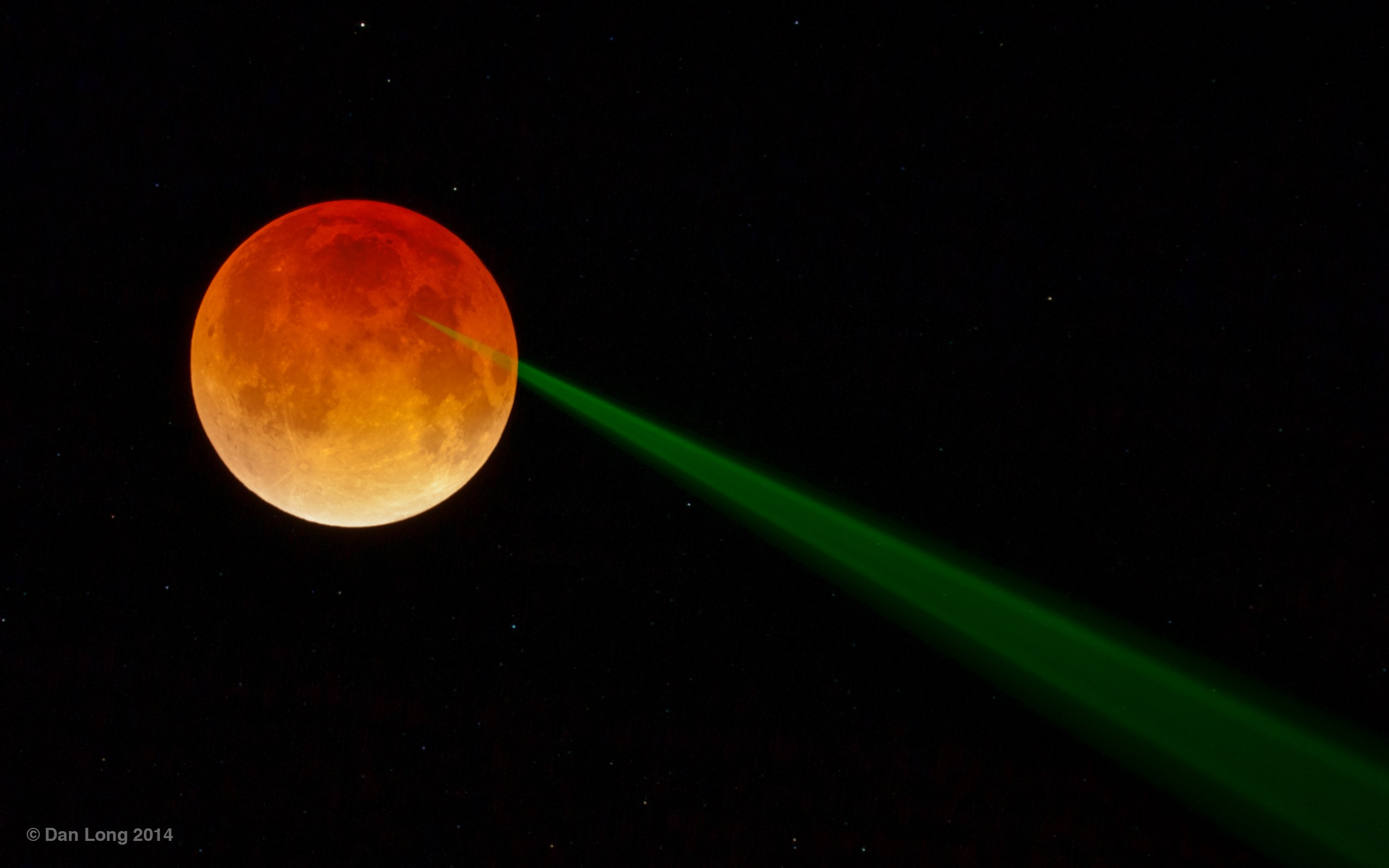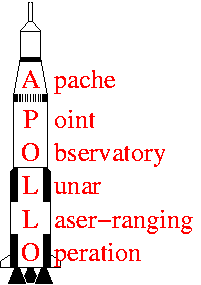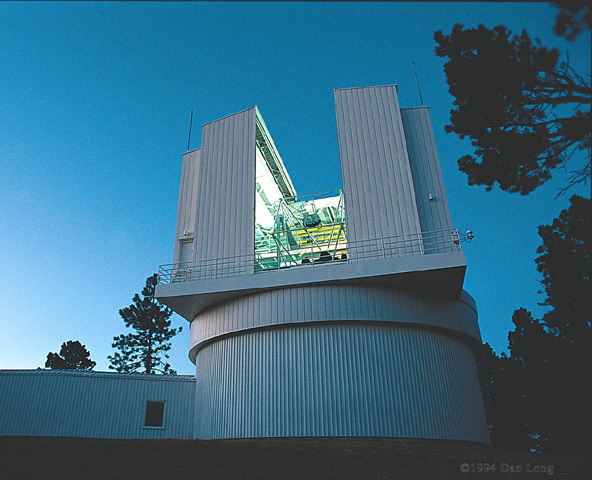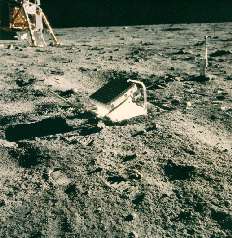The points of reference for the earth-moon measurement are the earth-based telescope—in this case, the 3.5 meter telescope at Apache Point, and in particular, the intersection of the telescope mount axes—and the small, suitcase-sized retroreflector array placed on the lunar surface by Apollo astronauts (pictured is the Apollo 11 reflector at Tranquility Base). A total of four lunar retroreflectors are functional: three Apollo reflectors from Apollo 11, 14, and 15 (three times bigger than 11 & 14), and one French-built, Soviet landed (unmanned) unit from the Luna 21 mission. A significant part of the challenge of lunar range modeling is converting this point-to-point measurement into a distance between the center-of-mass of the earth and the center-of-mass of the moon. It is only after this reduction that one can consider the interesting part of the problem: the dynamics of the earth-moon-sun system. For more general information on the technique, see this description of how the technique works and why we're performing this experiment.
APOLLO News:

Astronomy Picture of the Day, 2014.04.18
Eclipse observations resolve Full Moon Curse anomaly
APOLLO sets limits on Lunokhod rover azimuth
APOLLO continues to set records, run after run. See the observing-run highlights page and the monthly yield summaries for more.
APOLLO has seen it's own reflection! First Ranging Results include 2,400 return photons in 30 minutes, and confirmed accuracy at the inch-level (sort-of).
APOLLO began shooting its laser at the moon in July 2005. See pictures of the laser beam!!
The laser was installed on the telescope on 6/18/03. See pictures
Take a virtual tour of APOLLO to see the layout of the equipment.
The APOLLO Apparatus page provides details about (and pictures of) the hardware implementation
APOLLO Normal Point Data
Observing Aids
See screenshots from the APOLLO Graphical Interface
See the lunar pointer tool we use to assist in selecting targets and issuing track commands to the telescope
Published Information
- Review Article (PDF; 12 MB) describing the scienctific motivations, technique, history, modeling, and future prospects of LLR. Published in Reports on Progress in Physics, 76, 076901, (2013).
- Instrument Paper (PDF; 412 kB) detailing the as-constructed design of the apparatus. Published in PASP, 120, 20 (2008).
- APOLLO overview (PDF; 132 kB) as it appears in the conference proceedings of the 12th International Workshop on Laser Ranging, held in Matera, Italy, 13-17 November 2000. This paper is the most general APOLLO paper, and serves as a good introduction.
- System description (PDF; 435 kB), a modified version of the paper in the conference proceedings of the 13th International Workshop on Laser Ranging, held in Washington D. C., October 2002. This paper describes at some depth the multiplexed timing scheme employed in APOLLO.
- Improving LLR Tests of Gravitational Theory, Williams, Turyshev, & Murphy, International Journal of Modern Physics D, Vol. 13, No. 3 (2004) 567-582. This paper describes the science attainable by APOLLO, as well as some of the model advances required.
Recent Press Releases (the better ones...)
- San Diego Union Tribune, July 13, 2006, by Bruce Lieberman
- NASA Science Headline, May 6, 2004, by Patrick Barry
- San Francisco Chronicle, by Keay Davidson
- New York Times, by William Broad
- UW Press release, by Vince Stricherz
- ABC Online News, by Lee Dye
- New Scientist, by Will Knight
- Optics.org, by Jaqueline Hewett
Participating Scientists & Acknowledgments
- Tom Murphy (UCSD): astrophysicist; project leader
- Eric Adelberger (UW): gravitational physicist
- Christopher Stubbs (Harvard): astrophysicist
- Kenneth Nordtvedt (Northwest Analysis): gravitational theorist
- C. D. Hoyle (UW): postdoc
- Erik Swanson (UW): research physicist
- James Battat (Wellesley): Assistant Professor
- Eric Michelsen (UCSD): graduate student in physics
- Adam Orin (UCSD): graduate student in physics
- Eric Williams (UCSD): staff ressearch associate
- Bruce Gillespie (APO): Apache Point site director
- Jim Williams (JPL): LLR modeling/analysis
- Slava Turyshev (JPL): LLR modeling/analysis; gravitational theory
- Dale Boggs (JPL): LLR modeling/analysis
- Jean Dickey (JPL): LLR modeling/analysis
- John Goodkind (UCSD): physicist/gravimetry
In addition, a number of graduate and undergraduate students have been involved with APOLLO: Jana Strasburg (now Dr. Jana!), Tristan Hromnik, Jonathan Driscoll, Jesse Angle, Evan Million, Daniel Miller, Laura Tom, Charlie Barnhart, Matias Duran-Matute, Matt Stiglianese, Justin Ryser, and Laura Bodine.
APOLLO has benefited from the professional expertise of: Larry Carey, Peter Doherty, Erik Swanson, Sterling Fisher, Tim van Wechel, Allan Myers, Mark Klaene, Russell Owen, and Jeff Morgan. We are also tremendously grateful to our collaborators (Bernard Kosicki, Brian Aull, and Bob Reich) at MIT Lincoln Labs for the very productive access they have provided to their detector technology.
Finally, we thank NASA for supporting APOLLO and enabling it to get "off the ground", and more recently, a joint effort by NASA and the National Science Foundation to fund APOLLO at a level that will allow project completion and production of the first science results.


